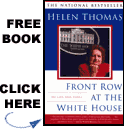|
|
On Sept. 8, 2002, the New York Times editors published Gordon and Judith Miller's fictions concerning aluminum tubes in Iraq supposedly part of Saddam's nuclear program. Much, much too late this bout of bridge-buying on the part of the Times duo prompted widespread derision, and finally the embarrassed Times editor banned Miller from bridge-buying altogether.
No such restraints were placed on Gordon. After lying low while Miller took the heat, he was back late last year, promoting the famous "surge," sold to him by General David Petraeus and others. Then, just this past Saturday, Feb. 10, the Times excitedly announced another major purchase.
The story was from the usual salesfolk, unnamed "American officials." Their mission: Get Gordon to boost Bush's anti-Iran propaganda drive by promoting the story that Iran is now supplying Iraqi Shiites with the new "explosively formed penetrator," the war's "most lethal weapon" now killing American boys in their Humvees, Bradleys and even Abrams tanks. "To make the weapon," Gordon confided to Times readers, "a metal cylinder is filled with powerful explosives. A metal concave disk manufactured on a special press is fixed to the firing end É According to American intelligence, Iran has excelled in developing this type of bomb, and has provided similar technology. The manufacture of the key metal components required sophisticated machinery, raw material and expertise that American intelligence agencies do not believe can be found in Iraq."
Now, the people attacking and killing most American troops in Iraq are not Shi'a but Sunni, and are therefore unlikely to have been supplied by Iran. Some 1,190 U.S. troops have been killed in Iraq since the start of the insurgency by roadside bombs, aka IEDs. One hundred and seventy American soldiers have been killed by EFPs since June 2004, less than 8 percent of the total killed in action.
Explosively formed penetrators are a not-so-recent variant on the 1888 Munroe Effect, the original idea behind the shaped charge. (My informant here is Pierre Sprey, a former weapons designer with the A-10 and F-16 planes on his resume.) A conventional-shaped charge is a copper (or other metal) funnel inside a cylindrical casing with the open end facing the target and with powder packed behind the narrow end. The powder is ignited behind the funnel, and an explosive shockwave collapses the funnel, creating a hot gas blowtorch jet carrying with it a slug of molten metal.
The EFD variation on this principle substitutes a bowl-like dish of copper for the funnel. This sacrifices the efficiency of the highly focused jet that drills the deepest possible hole in return for a slower, more cohesive slug of molten metal that will hang together even if the charge is detonated 20 to 100 feet from the target. Thus, the EFD warhead or bomb can be placed at or beyond the shoulder of a road (or on top of a concrete barrier or in the window of a house right on the road) aimed at the center of the road. When a vehicle or convoy comes along, the bomb can be fired manually by a remote and hidden insurgent (or triggered automatically by a garage door opener infrared beam); in other words, the EFD can be used like a hidden short-range-armor-piercing gun with little risk to the remote firer.
The front of an Abrams tank is heavily armored, but the back and sides of an Abrams have one-inch armor, which can be more easily pierced. Indeed, Sprey says a shaped charge of three inches in diameter can go through the back, sides or underneath of any tank in the world. The Bradley and Humvee are obviously more vulnerable. The U.S. DoD started developing small, highly refined EFD warhead bomblets dropped on parachutes and fired by miniature infrared or radar sensors in 1977 as part of the Assault Breaker program, though it's certain that the EFD idea is substantially older than 1977. The current USAF in-production EFP cluster bomb is called the CBU-97.
The first terrorist use of an EFD was in the 1989 assassination of German banker Alfred Herrhausen in his armored limousine, attributed to the Red Army Faction. This was almost certainly a homemade device made by unsophisticated means.
The improvised EFPs used in Iraq don't need to have Iranian-manufactured components. The necessary equipment consists of the copper bowl (a hand beaten one like they sell to tourists all over the Middle East is fine), a 6" to 9" diameter iron or steel sewer pipe or oil pipe (the oil pipe is excellent quality steel), a few pounds of explosive and a fuse. The 380 tons of US RDX explosive that went missing due to lax security would be ultra-high quality stuff for the job. All the insurgents need is one or two chalk talks or a videotape to learn how to make an EFP. That's all it takes to transfer the technology.
The use of EFPs in Iraq is old news indeed. They were first used by insurgents in late 2003 and have been used steadily -- in small numbers --since then.
Though the Times itself allowed a follow-up news story and an editorial to express caution about Gordon's alarums, his Feb. 10 story gave status to the government's scaremongering about Iran's role in Iraq. So there it is. Another bridge in Gordon's real estate portfolio, as the New York Times puts its editorial shoulder as it has done from the start. Punch Sulzberger told the grandees assembled in Davos last January, "I really don't know whether we'll be printing the Times in five years." Hasten the day.
© Creators Syndicate
Comments? Send a letter to the editor.Albion Monitor February
16, 2007 (http://www.albionmonitor.com)All Rights Reserved. Contact rights@monitor.net for permission to use in any format. |
|








